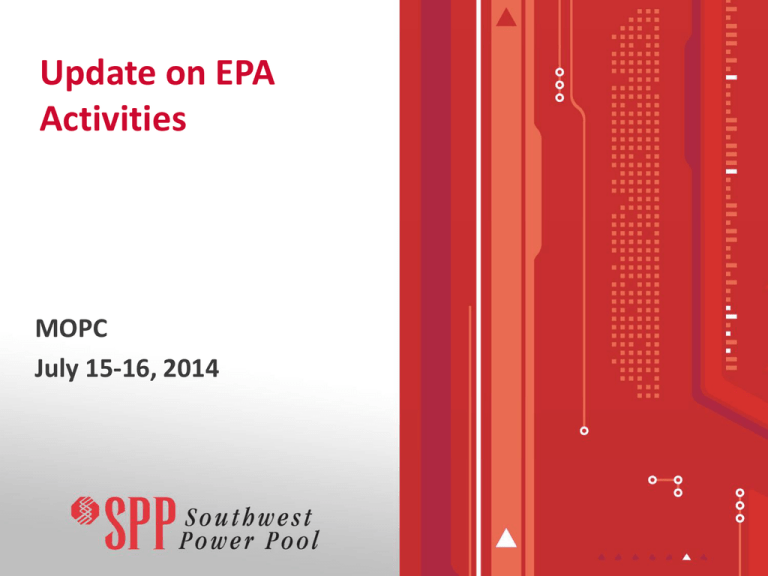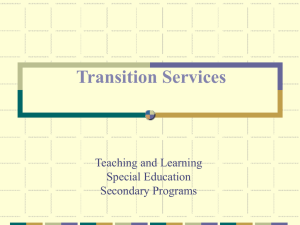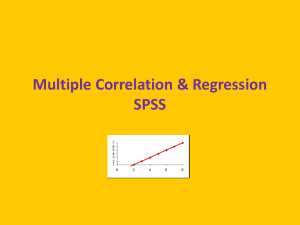EPA Status
advertisement

Update on EPA Activities MOPC July 15-16, 2014 Topics Covered • • Current Known Impacts – Retirements – De-ratings – Outage Impact Studies Proposed Clean Power Plan 2 CURRENT KNOWN IMPACTS 3 Impact on Coal in SPP (based on recent survey) Kansas (MW) 5,000 285 5,127 0 Arkansas (MW) 5,000 78 0 1,100 Comparison with ITP 10 Assumptions TOTAL CAPACITY OF COAL UNITS Future 1 2025 Future 2 2025 TOTAL CAPACITY OF COAL UNITS BY STATE 2018 Projection Future 1 6,000 Future 2 2018 30,000 5,000 25,459 25,000 22,863 4,000 20,475 15,000 Megawatts Megawatts 20,000 3,000 2,000 10,000 5,000 0 1,000 0 AR IA KS LA MO NE OK TX 5 Outage Impact Study * • • SPP bi-annual study process – Four-year look ahead for reliability issues – Weekly snapshots through the four years – Scheduled outages taken into account Current studies indicate there will be adequate time to perform generator retrofits necessary to comply with known environmental regulations – Retrofits are expected to impact generation supply economics more than the ability to reliably serve load * Formerly called “EPA Study” 66 Outage Impact Study Resource Adequacy 2014 2014 Weekly Outages 67,678 7 Outage Impact Study Resource Adequacy 2015 2015 Weekly Outages 67,678 8 PROPOSED CLEAN POWER PLAN 9 EPA Clean Power Plan Overview • EPA’s proposed performance standards to reduce CO2 emissions from existing fossil fuel-fired generators • Promulgated under authority of Section 111(d) of the Clean Air Act • Achieves nationwide 30% reduction of CO2 from 2005 levels by 2030 • Proposes state-specific emission rate-based CO2 goals – Based on EPA’s interpretation and application of Best System of Emission Reduction (BSER) – Must be met by 2030 10 EPA Clean Power Plan Overview • States goals and flexibility – Interim goals applied 2020-2029 that allows states to choose trajectory – Offers guidelines and allows states flexibility to develop and submit State Implementation Plans – States may adopt an equivalent mass-based goal • States can develop individual plans or collaborate with other states • If state does not submit a plan or its plan is not approved, EPA will establish a plan for that state 11 Clean Power Plan Milestones June June 2, June 2017 2014 2015 Draft rule issued Final rule expected State plans due (with one-year extension) January 2020-29 Interim goal in effect Oct 16, June June January 2014 2016 2018 2030 Comments due to EPA State Implentation Plans due Multi-state plans due (with two-year extension) Final goal in effect 12 BSER is Based on Four Building Blocks Block Assumption 1. Improve efficiency of existing coal plants 6% efficiency improvement across fleet, assuming best practices and equipment upgrades 2. Increase reliance on CC gas units Re-dispatch of Natural Gas CCs up to a capacity factor of 70% 3. Expand use of renewable resources and sustain nuclear power production Meet regional non-hydro renewable target, prevent retirement of at-risk nuclear capacity and promote completion of nuclear capacity under construction 4. Expand use of demand-side energy efficiency Scale to achieve 1.5% of prior year’s annual savings rate *Uses 2012 data for existing units and estimated data for units under construction. 13 SPP State Goals by 2030 Fossil Unit CO2 Emission Rate Goals and Block Application (lbs/MWh) 3,000 2439 2368 2331 2320 2256 2162 2010 2,000 1798 1,500 1771 1783 1722 1562 1714 1499 1479 1533 1420 1544 SPP State Average 1,000 2030 Rate = 1,045 1048 910 895 883 Louisiana SPP State Average 2012 Rate = 1,699 Oklahoma 2,500 741 791 500 Final Goal Energy Efficiency Renewable Nuclear Redispatch CCs *Includes Future States with IS Generation in SPP (N. Dakota, S. Dakota, Montana, and Wyoming) Texas Arkansas New Mexico Missouri Nebraska S. Dakota Kansas Wyoming N. Dakota Montana 0 Heat Rate Improvement 14 SPP State % Emission Reduction Goals Total CO2 Emission Reduction Goals (%) 80 70 60 50 Average of SPP States = 38.5% 40 30 20 10 *Includes Future States with IS Generation in SPP (N. Dakota, S. Dakota, Montana, and Wyoming) Missouri N. Dakota Wyoming Montana Nebraska Kansas New Mexico Louisiana Oklahoma Texas Arkansas S. Dakota 0 15 EPA Projected 2016-2020 EGU Retirements (For SPP and Select Neighboring States) 13000 12000 11000 10000 9000 MW 8000 7000 6000 5000 4000 3000 2000 1000 0 AR KS MO MT ND Coal Steam *Excludes committed retirements prior to 2016 **AEP provided data extracted from EPA IPM data NE NM Oil/Gas Steam OK SD TX IA LA CT 16 SPP State Efforts Underway • • Arkansas – ADEQ has already had two stakeholder meetings, June 25th & May 28th – Next stakeholder meeting August 28th – SPP Staff met with ADEQ to provide an SPP overview Missouri – • Nebraska – • SPP Staff meeting with NDEQ and Nebraska utilities on July 30th Oklahoma – • Stakeholder meeting scheduled by MoPSC on August 18th Meeting being scheduled in August with stakeholders Texas – Public workshop scheduled by PUCT on August 15th 17 How Can SPP Assist? Help educate and work with states Perform impact analyses – Inform stakeholder responses that are due October 16 – Inform current planning efforts – Assist state and member decision making Facilitate coordinated SPP response to proposed Clean Power Plan Evaluate and facilitate regional approach Coordinate with neighbors Other ways? 18 SPP’s Proposed Impact Analysis Framework • Perform both reliability and economic analyses – Use 2024 ITPNT and ITP10 Future 2 models as base case – Develop two scenarios – Identify incremental reliability problems and increased APC • Perform gas price sensitivity in economic analysis • Perform load scaling sensitivity in reliability analysis • Report results by October 1 19 Proposed Impact Analysis Scenarios Parameter Scenario 1 Scenario 2 Coal 50% retirement 20% retirement NGCCs* Increase capacity factor to 70% Increase capacity factor to 50% Wind At least 50% capacity increase, assume additional state RPS At least 50% capacity increase Energy Efficiency 1% of load 3% of load Demand Response None None Carbon Tax None $30/ton *Will attempt to use existing capacity to replace coal up to existing capacity margin requirements 20











